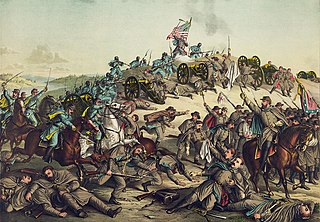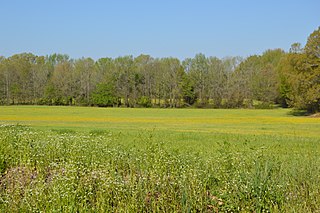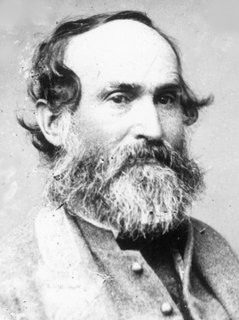
The Battle of Fredericksburg was fought December 11–15, 1862, in and around Fredericksburg, Virginia, in the Eastern Theater of the American Civil War. The combat, between the Union Army of the Potomac commanded by Maj. Gen. Ambrose E. Burnside and the Confederate Army of Northern Virginia under Gen. Robert E. Lee, included futile frontal attacks by the Union Army on December 13 against entrenched Confederate defenders on the heights behind the city. It is remembered as one of the most one-sided battles of the war, with Union casualties more than twice as heavy as those suffered by the Confederates. A visitor to the battlefield described the battle to U.S. President Abraham Lincoln as a "butchery".

Samuel Ryan Curtis was an American military officer, and one of the first Republicans elected to Congress. He was most famous for his role as a Union Army general in the Trans-Mississippi Theater of the American Civil War, especially for his victories at the Battles of Pea Ridge in 1862 and Westport in 1864.

The Battle of Franklin was fought on November 30, 1864, in Franklin, Tennessee, as part of the Franklin–Nashville Campaign of the American Civil War. It was one of the worst disasters of the war for the Confederate States Army. Confederate Lt. Gen. John Bell Hood's Army of Tennessee conducted numerous frontal assaults against fortified positions occupied by the Union forces under Maj. Gen. John Schofield and was unable to prevent Schofield from executing a planned, orderly withdrawal to Nashville.

The Battle of Nashville was a two-day battle in the Franklin-Nashville Campaign that represented the end of large-scale fighting west of the coastal states in the American Civil War. It was fought at Nashville, Tennessee, on December 15–16, 1864, between the Confederate Army of Tennessee under Lieutenant General John Bell Hood and the Union Army of the Cumberland under Major General George H. Thomas. In one of the largest victories achieved by the Union Army during the war, Thomas attacked and routed Hood's army, largely destroying it as an effective fighting force.

John Sedgwick was a military officer and Union Army general during the American Civil War.

The Battle of Chaffin's Farm and New Market Heights, also known as Laurel Hill and combats at Forts Harrison, Johnson, and Gilmer, was fought in Virginia on September 29–30, 1864, as part of the siege of Petersburg in the American Civil War.

The Siege and Battle of Corinth Sites are a National Historic Landmark District encompassing surviving elements of three significant American Civil War engagements in and near Corinth, Mississippi. Included are landscape and battlefield features of the Siege of Corinth, the Second Battle of Corinth, and the lesser Battle of Hatchie's Bridge on October 5, 1862. The district includes features located in both Alcorn County, Mississippi and Hardeman County, Tennessee, with some of the former preserved as part of Shiloh National Military Park. It was designated a landmark in 1991.

Fort Pocahontas was an earthen fort on the north bank of the James River at Wilson's Wharf, in Charles City County, Virginia which served as a Union supply depot during the American Civil War. The fort was constructed by African-American soldiers of the United States Colored Troops under the command of Brig. Gen. Edward Augustus Wild.

The Battle of Pleasant Hill occurred on 9 April 1864 and formed part of the Red River Campaign during the American Civil War when Union forces aimed to occupy the Louisiana state capital, Shreveport.

Carnton is a historic home and museum in Franklin, Williamson County, Tennessee, United States. The plantation played an important role during and immediately after the Battle of Franklin during the American Civil War. It is managed by the non-profit organization The Battle of Franklin Trust.

The Carter House State Historic Site is a historic house at 1140 Columbia Avenue in Franklin, Tennessee. In that house, the Carter family hid in the basement waiting for the second Battle of Franklin to end. It is a Tennessee Historical Commission State Historic Site, managed by the non-profit organization The Battle of Franklin Trust under an agreement with the Tennessee Historical Commission. The house is a contributing property and centerpiece of the Franklin Battlefield, a U.S. National Historic Landmark historic district.

John Herbert Kelly was, at the time of his promotion, the youngest brigadier general in the Confederate States Army. He became one of the youngest generals to die during the American Civil War, at the age of 24. His death occurred during an engagement at Franklin, Tennessee on September 2, 1864 during Major General Joseph Wheeler's raid into Tennessee in August and early September 1864 in an attempt to destroy the railroad that Union Army Major General William Tecumseh Sherman was using to supply his force from Chattanooga, Tennessee during the Atlanta Campaign.

Jubal Anderson Early was a Virginia lawyer and politician who became a Confederate general during the American Civil War. Trained at the United States Military Academy, Early resigned his U.S. Army commission after the Second Seminole War and his Virginia military commission after the Mexican–American War, in both cases to practice law and participate in politics. Accepting a Virginia and later Confederate military commission as the American Civil War began, Early fought in the Eastern Theater throughout the conflict. He commanded a division under Generals Stonewall Jackson and Richard Ewell, and later commanded a corps. A key Confederate defender of the Shenandoah Valley, during the Valley Campaigns of 1864, Early made daring raids to the outskirts of Washington, D.C., and as far as York, Pennsylvania, but was crushed by Union forces under General Philip Sheridan, losing over half his forces and leading to the destruction of much of the South's food supply. After the war, Early fled to Mexico, then Cuba and Canada, and upon returning to the United States took pride as an "unrepentant rebel." Particularly after the death of Gen. Robert E. Lee in 1870, Early delivered speeches establishing the Lost Cause position. Early helped found the Southern Historical Society and memorial associations.

Glen Willis is a building in Frankfort, Kentucky that was built as a brick, two-story house in 1815. A third story was added when it was remodelled by Henry Harrison Murray after 1841.

Fort Granger was a Union fort built in 1862 in Franklin, Tennessee, south of Nashville, after their forces occupied the state during the American Civil War. One of several fortifications constructed in the Franklin Battlefield, the fort was used by Union troops to defend their positions in Middle Tennessee against Confederate attackers. The Second Battle of Franklin in 1864, part of the Franklin-Nashville Campaign in the Western Theater, was the most notable engagement of this area during the Civil War.

The Apheus Truett House ia a frame house located at 228 Franklin Road in Franklin, Tennessee, that was listed on the National Register of Historic Places (NRHP) in 1988. Buit in 1846, it is a notable example of a two-story vernacular I-house structure in Williamson County. It includes Central passage plan architecture. The NRHP listing is for an area of 5.2 acres (2.1 ha), with one contributing building and two non-contributing structures.

Milford Battlefield is situated in Overall, Virginia in Warren County and Page County, Virginia. It was the site of a battle on September 22–24 during the Valley campaigns of 1864 in the American Civil War. The site is located on property now privately owned.

Winstead Hill is a property in Franklin, Tennessee that has significance in 1864 for being in the Second Battle of Franklin battlefield. It is located within the Franklin Battlefield, a U.S. National Historic Landmark area.

Ellerslie is an historic home located at Colonial Heights, Virginia. It is a large 2+1⁄2-story, hip-roofed, Italian Villa style dwelling with a two-story rear service wing connected by an arcade. It features a three-story tower with a hipped roof and a full-width front porch.

Chretien Point Plantation is a pre-Civil War twelve room red brick mansion, located on twenty acres on the banks of Bayou Bourbeaux, two miles southwest of Sunset, Louisiana in St. Landry Parish. A Civil War battle was fought on the plantation grounds and Jean Lafitte was a tenant. The mansion was listed on the National Register of Historic Places in 1977.






















